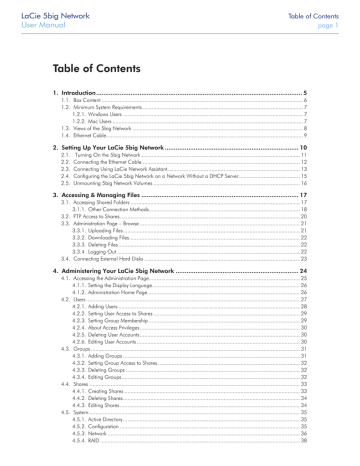- Computers & electronics
- Data storage
- Data storage devices
- NAS & storage servers
- LaCie
- 5big Network
- User manual
advertisement

LaCie 5big Network
User Manual
RAID and Disks
page 55
5.6. RAID 10
RAID 10 (also called RAID 1+0) is another RAID level that combines the attributes of other levels, specifically RAID 1 and RAID 0. It is a
“stripe of mirrored sets”, meaning that data is striped across two mirrored arrays (
Fig. 88 ). The Striping occurs between arrays and the
mirroring occurs within the same array, which makes the rebuilding very fast. RAID 10 arrays should have disks in multiples of four. For
LaCie products with five disks, in a RAID 10 array, the fifth disk will either be a spare or will be unused. See the diagram at right.
In a RAID 10 array, one disk from each mirrored pair can fail with no data loss. However, the working disk in an array with a failed disk becomes a weak point for the entire array. If the second disk in a mirrored pair fails, the entire array is lost.
Applications
RAID 10 provides good speeds because of RAID 0 striping, but cuts the available capacity of a device in half (assuming all disks in the array have the same capacity).
How RAID 10 Capacity Is Calculated
Each disk in a RAID 10 system should have the same capacity.
Storage capacity in a RAID 10 configuration is calculated by multiplying the number of drives by the disk capacity and dividing by 2, or
C = n*d/2 where:
C = available capacity n = number of disks d = disk capacity
For example, in a RAID 10 array with four drives each with a capacity of 1000GB, the total capacity of the array would be 2000GB:
C = (4*1000)/2
Fig. 88
RAID 10
A1
A3
A5
A7
Disk 1
RAID 1
A1
A3
A5
A7
Disk 2
RAID 0
A2
A4
A6
A8
Disk 3
RAID 1
A2
A4
A6
A8
Disk 4
advertisement
* Your assessment is very important for improving the workof artificial intelligence, which forms the content of this project
Related manuals
advertisement
Table of contents
- 5 1. Introduction
- 6 1.1. Box Content
- 7 1.2. Minimum System Requirements
- 7 1.2.1. Windows Users
- 7 1.2.2. Mac Users
- 8 1.3. Views of the 5big Network
- 9 1.4. Ethernet Cable
- 10 2. Setting Up Your LaCie 5big Network
- 11 2.1. Turning On the 5big Network
- 12 2.2. Connecting the Ethernet Cable
- 13 2.3. Connecting Using LaCie Network Assistant
- 15 2.4. Configuring the LaCie 5big Network on a Network Without a DHCP Server
- 16 2.5. Unmounting 5big Network Volumes
- 17 3. Accessing & Managing Files
- 17 3.1. Accessing Shared Folders
- 18 3.1.1. Other Connection Methods
- 20 3.2. FTP Access to Shares
- 21 3.3. Administration Page – Browse
- 21 3.3.1. Uploading Files
- 22 3.3.2. Downloading Files
- 22 3.3.3. Deleting Files
- 22 3.3.4. Logging Out
- 23 3.4. Connecting External Hard Disks
- 24 4. Administering Your LaCie 5big Network
- 25 4.1. Accessing the Administration Page
- 26 4.1.1. Setting the Display Language
- 26 4.1.2. Administration Home Page
- 27 4.2. Users
- 28 4.2.1. Adding Users
- 29 4.2.2. Setting User Access to Shares
- 29 4.2.3. Setting Group Membership
- 30 4.2.4. About Access Privileges
- 30 4.2.5. Deleting User Accounts
- 30 4.2.6. Editing User Accounts
- 31 4.3. Groups
- 31 4.3.1. Adding Groups
- 32 4.3.2. Setting Group Access to Shares
- 32 4.3.3. Deleting Groups
- 32 4.3.4. Editing Groups
- 33 4.4. Shares
- 33 4.4.1. Creating Shares
- 34 4.4.2. Deleting Shares
- 34 4.4.3. Editing Shares
- 35 4.5. System
- 35 4.5.1. Active Directory
- 35 4.5.2. Configuration
- 36 4.5.3. Network
- 38 4.5.4. RAID
- 39 4.5.5. Disks
- 41 4.5.6. Status
- 41 4.5.7. Maintenance
- 44 4.5.8. System Log
- 45 4.5.9. Wake on LAN (WOL)
- 46 4.6. Download
- 47 4.7. Backup
- 48 4.8. Browse
- 48 4.9. Import (Snapshot)
- 49 4.10. Multimedia
- 50 5. RAID and Disks
- 50 5.1. Changing the RAID Level
- 51 5.2. RAID
- 52 5.3. RAID
- 53 5.4. RAID 5+Spare
- 54 5.5. RAID
- 55 5.6. RAID
- 56 5.7. Installing a New Disk
- 57 6. LED Indicators
- 58 7. Email Notification Triggers
- 59 8. Troubleshooting
- 61 9. Contacting Customer Support
- 62 8.1. LaCie Technical Support Contacts
- 63 10. Warranty Information